Making Torta di Bietola
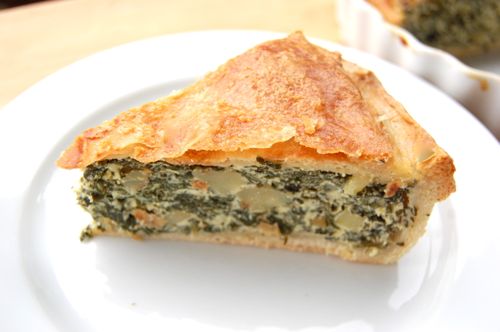
Though this Italian pie is made with Swiss chard (“bietola”), I should point out that the general approach I’ve laid out here can be used with a wide variety of greens (spinach, broccoli rabe, etc.). Or you can banish the vegetables entirely, add more cheese, diced ham and/or Italian deli meats and you’ll have a torta di pasqua, an Italian Easter pie.
Though you can employ a variety of crusts for this sort of a pie, I highly recommend one made from bread or pizza dough. You’ll get a much lighter, much less achingly rich result than you would with a short crust or conventional laminated dough (like puff pastry). And that’s a good thing when the filling already abounds with cheese and eggs. You don’t have to employ the multi-layer stretching technique that I’m demonstrating below if you find it intimidating (however it does introduce a unique textural dimension to the pie, so if you’re at all inclined I recommend trying it).
But let’s get to it — time’s a-wastin’! Begin with about two pounds of chard. This is pretty much the last of the chard from our backyard garden. Wash the leaves thoroughly.
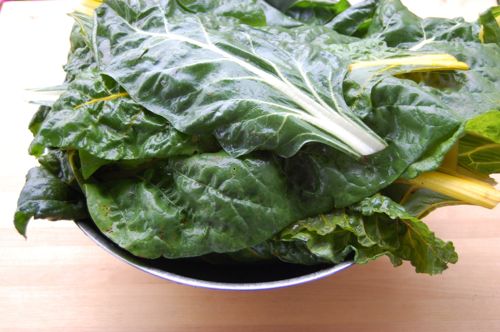
Now to remove the stems. Lay a leaf out in front of you, stem up.
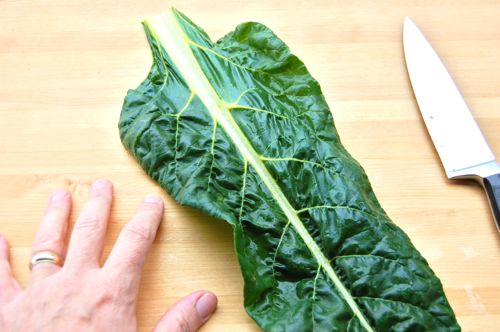
Fold it in half…
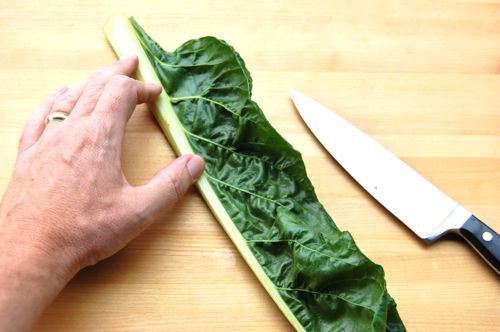
…and run a knife down the stem, cutting the leaf away (camera hand not shown). Discard the stem.
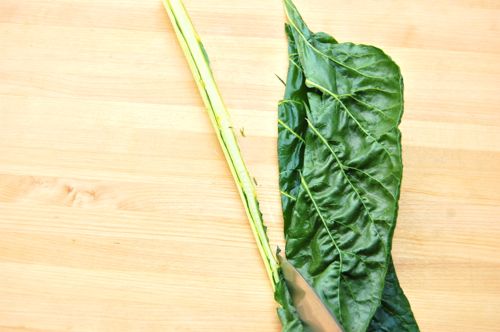
Now just roll up the leaf…
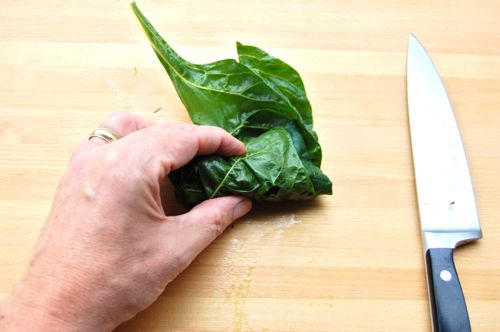
…and slice the roll into shred-like pieces.

Pour all that into a pot of amply-salted water (it should taste like sea water).
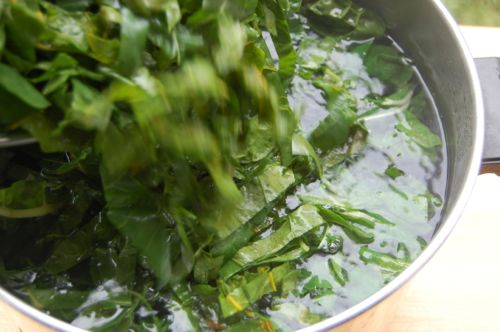
Simmer the chard for 3-7 minutes until it’s tender, then remove it to an ice bath (this helps retain the color).
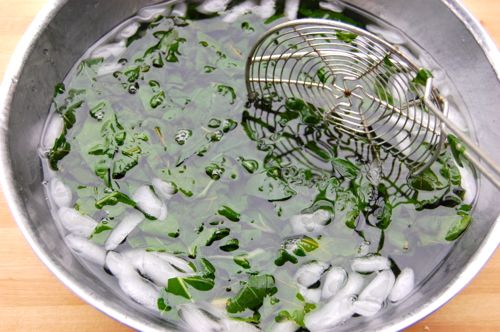
Drain it, then transfer it to a cutting board and chop the chard down until it’s in small pieces. If you prefer to leave it in larger pieces, do.
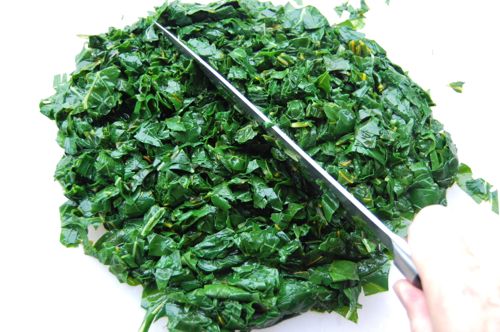
Press the chard between paper towels until you’ve got most of the water squeezed out.

Ready! Transfer that to a medium bowl.
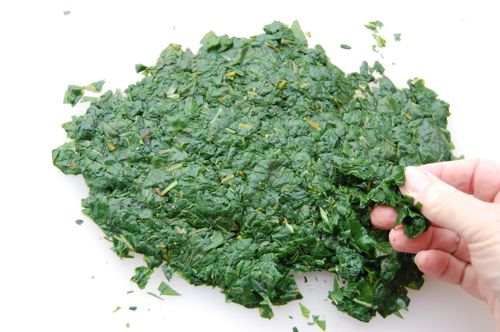
Chop your garlic and small onion finely.
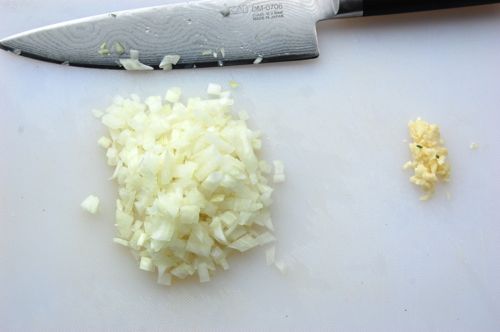
Heat the oil in a medium sauté pan and add the garlic. Let it cook about 20 seconds.
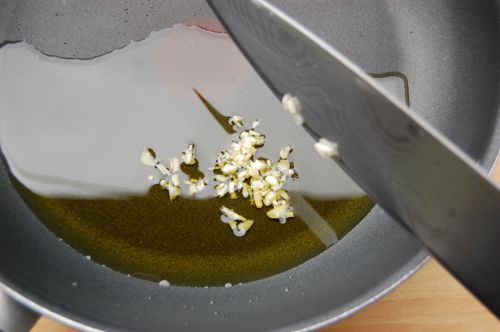
Then add the onion. I’m also adding some cooked diced potato here. We had one little spud left after the girls dug potatoes Sunday. I boiled it for 15 minutes in the chard water then cut it into cubes. It’s a fair addition to a torte of this type. A little pancetta is also perfectly legal.
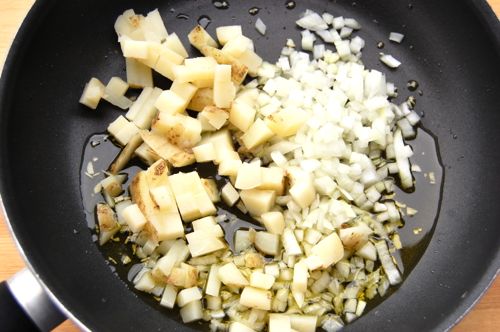
Sauté it all for about 7-10 minutes over medium-high heat, then add it to the chard, and stir everything together.
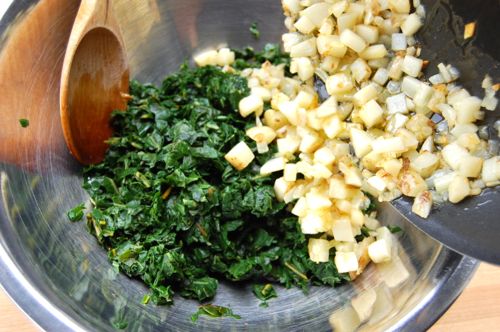
Next combine the cheeses and eggs and stir until they’re well combined.

Stir mixture A into mess B.
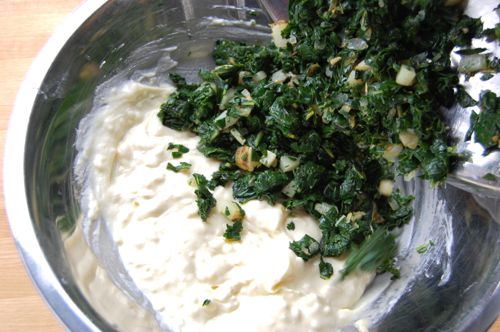
Grate in some nutmeg and add pepper and salt to taste. Now set that aside while you work on the crust.

Your pizza dough needs to have risen at least three hours by this point, or more. You can make it the same day or the night before. It should be very spongy and light. If it’s over-proofed, that’s perfectly OK, since that will only make the dough more pliable. You’ll have about two and a half pounds (which is a lot more than you really need, but it’s nice to have excess). You want to cut it into four pieces, one weighing about a pound, the others weighing about half a pound each.
So, secure your mold and butter it.
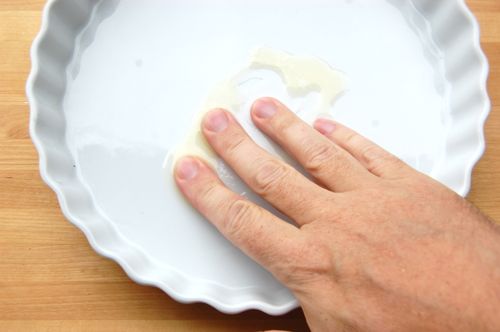
Cut about a 1-pound piece of dough off the mass. This will be your bottom crust. With floured hands, pat it down like a pizza or roll it out with a pin if you prefer. You want a circle about 10 inches across.
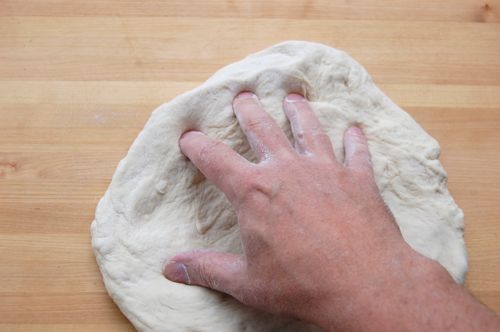
Drape the dough over the back of both fists and slowly open your hands, stretching the dough out. Take your time with this step, because depending on how long it’s risen, it may be stubborn. If you see the surface of the dough start to tear, put the dough back down and let it rise another hour until it becomes more cooperative.

Don’t stretch it see-through thin, and don’t worry if the edges are thick and doughy, you’re going to trim those off. Lay your sheet over the form and press it down a little. Now stretch the dough away from the sides to thin the overhang.
Here I should point out that we American bakers are at a disadvantage here relative to Italian (or other Continental) bakers. The gluten on our side of the pond is very elastic, which means it snaps back when you stretch it. Sustained pressure is the only thing that loosens the dough up (i.e. breaks some of those gluten strands), so if you have to tug and hold for a few seconds, that’s fine. Just be patient, though dough’s not going anywhere.

Once you’re satisfied that the bottom crust is thin enough, trim off the excess (there will be a fair amount of it).

Now put in your filling. If you want to get nuts here, you can crack two or three raw eggs on the top (the torta will bake up with a layer of cooked egg on the top, which looks pretty cool).
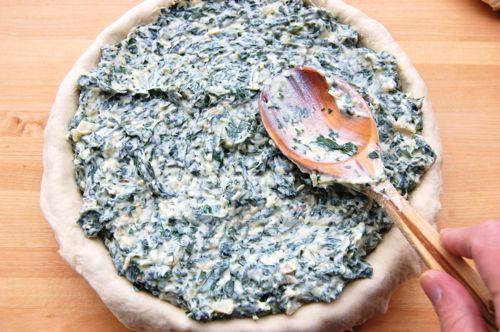
Repeat the patting and stretching process for one of the smaller pieces of dough. This time stretch it to the point that you can see through it in spots. Lay it on top of the filling and trim off the excess.

Paint on some melted butter.
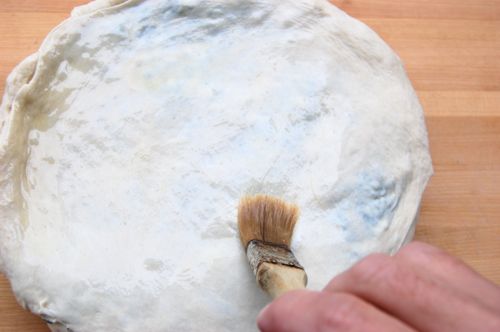
Add another thin layer…butter it…
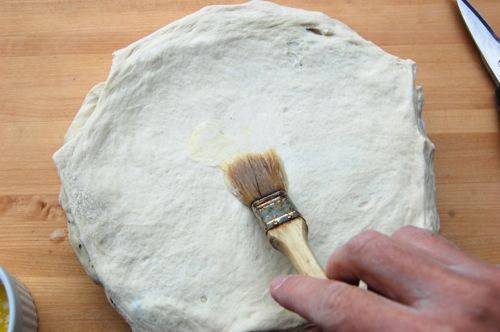
…and do it again. Something else I realized while doing this is that tortas like these are clearly the inspiration for Chicago-style “stuffed pizzas.” Much as I enjoy a slice of one every so often, if I were Secretary General of the Pizza U.N., I’d never recognize those things as members. Cheese pies are what they are. But I digress…do the stretch-layer-butter routine one more time.
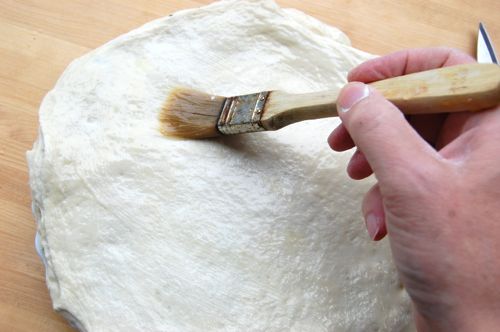
Now bring up the overhanging dough and make a crimp around the edge. It need not be fancy, this is a rustic pie, remember.
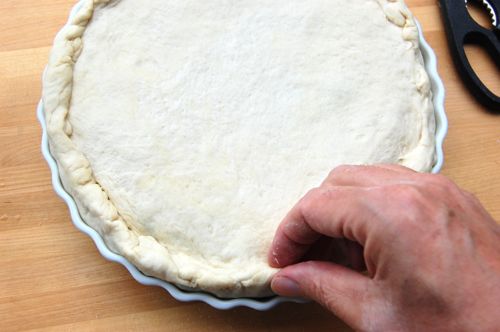
Paint on some egg wash and bake the pie for 45 minutes to an hour, until the top crust gets nice and brown.
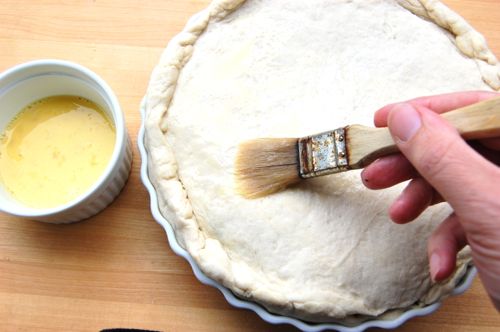
About like this.
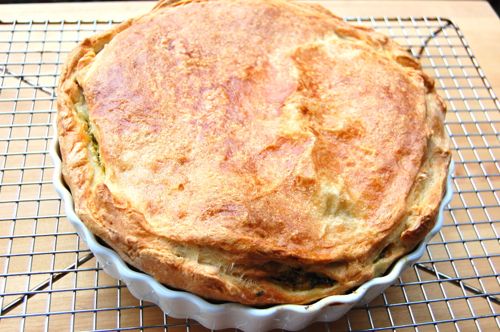
Let it sit for about 20 minutes before you serve it. If you serve it right away it will be crunchy on the top, which is a nice textural contrast, however this is fantastic at room temperature or even cold. Just slice it into wedges and serve!
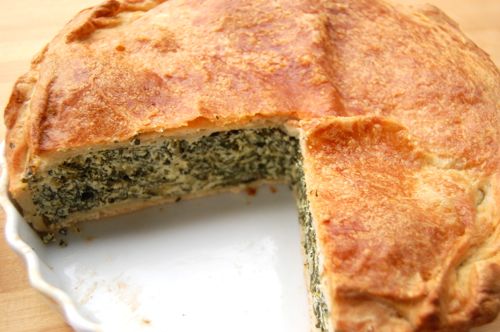
That hand-laminated yeast dough really is a unique experience. Very glad I tried it. Buon appetite.
It looks kinda like a quiché but it sounds more delicious. I think I´ll make it but with a twist, with a little bit of ricotta and I’ll definetly add some pancetta thanks for the idea!
http://bitstreats.blogspot.com/
Sounds good, Betty! Give me a full report! The recipe is down at the end of the page, use it for a reference if you like.
Cheers,
– Joe
WOW. looks amazing, can’t wait to try this! and now i know a ton about torta bietola, too! Thanks Joe 🙂
Thanks Ann! Let me know how it turns out!
– Joe
Looks very similar to spanakopita.
Hey Bronwyn!
It is rather, just bigger and with a yeast dough. And of course with the silverbeet! 😉
– Joe
hi Joe, is it true that vegetables (especially greens) loose all their nutrients if they are washed afted shredding..? My mom is such a purist that she doesnt waste the water that we wash rice..(funny! yet happens..). Smart way to incorporate these into kids menu.
That’s a good question, HP! I don’t know for sure, though the water is pretty green after only 3 minutes or so. There’s no question there’s some loss to the water, but whether that constitutes a catastrophic loss of flavor and/or nutritional value I can’t say. I’m sure the chard is well worth eating either way.
– Joe
Hey Joe really great job! I love the idea of stretching
the top layers, to get a crispy top, and the extra
butter don’t hurt! I actually think I like the veggie
version a little more than the meat. My nonna
would be proud!
Thanks Ben! It was fun. That stretching technique was really very easy…and created an effect I was very impressed with. I’m enamored with laminated doughs that only have a few layers. I once tasted a potato galette that was made from a dough like that. It was surely folded, but only once, and was leaner than a conventional puff or croissant dough. I want to replicate that one of these days. This was a first step…the flavor and texture were almost identical.
Oh yes, for extra crunch leave out the olive oil!
Cheers,
– Joe
hi there, my name is stefano and i write to u from Milano.
very good blog end excellent explanation.
pies of this sort are typical of Ligurian cooking (north-west Itatly). basically you can use whatever vegetable you have: they also make a good one with pumpkin. a popular version combines uncooked rice, sauted onion, and raw chopped-grated vegetables (plus ricotta and eggs and cheese): the rice cooks in the water released by the vegetables.
in Liguria they would not use a bread-pizza dough, but a simple flour + salt+olive oil+ water dough (sometimess with some white wine in it). this version with butters sounds delicious (it must be good also with lard or goose fat).
ciao from milano and keep up the excellent work
stefano
ps Nick Malgieri in the Modern Baker has a similar thing (tourte) as well as Hazan’s essentials.
Stefano, thank you for the email! Your excellent information will make a very useful addition to the post. It’s an interesting point you bring up about the dough. At first I considered an unleavened dough, but after an early experiment I realized how difficult it would be using American flour. Our gluten is so elastic compared to yours, it’s almost impossible to stretch or roll an unleavened dough thin enough. Gas bubbles (from yeast) are the only way I could think of to give it “stretch.”
But I’ll keep trying, I’m sure. I may come up with a solution one of these days. Thank you again for your generous comments, and do come back to visit when you can.
– Joe
I tend to use what it is called oo flour: 9.1 g protein/100 g flour… basically it is the one we use for pastry.
Often I also throw in a few TBSP of whole wheat flour…
In the older recipe, especially the one for the Easter pie (torta pasqualina), I have seen 33 layers of transparent-thin dough being used. I never do that. I tend to stick to 6-8 layers, brushed with olive oil.
In Liguria, which is a small region (mostly mountains + not famous for its cheese) a soft, slightly tangy cheese is used, it is called prescinseua, which is unobtainable outside Liguria. It is softer than ricotta and with a light tang. I think Lynne Rossetto Kasper gives the recipe somewhere (that is to say: how to make a good substitute). Lately I have been experimenting with half ricotta and half creme fraiche and even half ricotta and half Greek yogurt, with good results (but I do like that tangy flavour and I think goes well with the greens).
ciao
stefano
Very interesting. I suppose the solution is simply to get some Italian 00 flour…which isn’t easy to find, actually.
Regarding the layers, it seems to me that if you were employing 33 layers of stretched dough, you might as well be using puff pastry. For a rustic pie like this, six or eight seems like plenty. Thanks again for all the good information!
– Joe
… puff pastry: modern recipes do call often for puff pastry actually, and delicious that pie will be!
But, I think, it would be also … kind of betraying the simple and humble origins of this recipe.
but, as always, it is also a matter of taste
ciao
s
Ciao indeed!
– Joe
Great pie! I just made one according to Nicola’s recipe for la tiella, apparently a specialty in his hometown of Gaeta; here in lebanon, people use flour 00 for making pie like this.
I wish I could by that over here. It’s not only rare, it’s extremely expensive. I got a good result with American flour, but access to the real thing would be nice!
Great to meet you, T.O.B.!
– Joe
I love chard pies, and your top crust looks absolutely amazing. I was mostly disappointed with the crusts I had on chard pies in Nice. I will be trying your stretch and butter technique.
That said, two things drive me crazy about how people cook with chard. 1.) If you are going to be sauteing onions and garlic, why not chop the stems and add them to the saute instead of throwing them away? 2.) Why boil? Just add the shredded chard leaves to the saute and cook them down—no extra pan, no extra liquid, and I usually find there is no need to do a big squeeze thing. If there is a little liquid in the pan as it cools, I just drain the chard mix and go.
Great tips, Carol. Thanks very much!
– Joe
I’ve got one more. Removing the stems goes twice as fast if you fold the leaf in half (with the bottom of the leaf on the outside) and cut along the side of the stem. Did I say I love chard?!?
Sorry, Joe! I just saw that you do that! Oops!i
No problem, Carol. You never know what I might forget!
– Joe